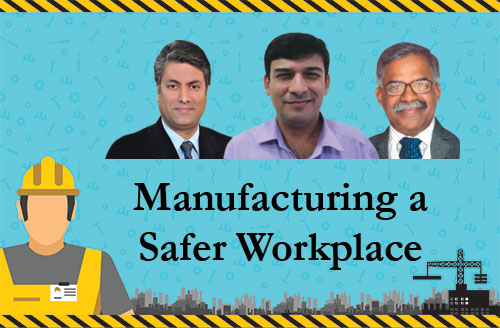In the last few years, approach towards safety has taken a paradigm shift, especially in multinational companies, which have accelerated their initiatives to be compliant with international standards and improve their brand image. ISR takes a look at some of the key safety measures and reforms
From drugs and pharmaceutical manufacturing to food production and metal fabrication, the manufacturing industry encompasses a diverse range of segments. While each of these varied segments is quite different from the other in terms of functioning, one thing is common. Employees at these segments face safety risks due to the nature of their work.
Traditionally, industrial safety has not been high on the radar for Indian companies. So much so that a number of industrial fatalities were not even documented and there was no comprehensive data on the number of safety accidents and injuries. To get a clear picture, consider the official statistics for documented fatalities in Indian factories between 2010 and 2012. While the official figure suggests that there were 4,275 fatalities during the period, analysts estimate that the actual number even by the most conservative estimate could be ten times higher.
While safety landscape in the manufacturing units in the interiors of the country is still abysmal, the condition has vastly improved in big firms. There has actually been a sea-change in the attitude towards safety and big firms are now considering it as an ‘investment’ rather than ‘cost.’ This is primarily because safety incidents are major business disruptor and these accidents not only impact business continuity but also have an adverse impact on the company’s brand image.
“Business leadership and continuity is at the centre-stage of every manufacturing organization with cost, quality, servicing and EHS (Environment, Health and Safety) as the cornerstones. Good EHS managed through line function means good business,” asserts Harish Verma, Vice President – HSE, Cipla.

“We maintain focus on inherent safety, i.e. machinery used in our plants have in-built safety features to prevent safety incidents” Harish Verma, Vice President – HSE, Cipla
Some forward-looking manufacturing companies are even adopting safety as part of their culture. Let’s look at some of the key safety measures taken by these firms:
Focusing on Inherent Safety
Proactive manufacturing organizations are emphasizing on adopting a risk-based approach, wherein they analyze potential risks and take appropriate measures in advance to avoid any potential disruptions. For these organizations Personal Protective Equipment (PPE) is the last resort, as the focus is on minimizing the risk at source itself. Take the case of leading pharmaceutical manufacturer Cipla, which is focusing on maximizing use of green chemistry in designing manufacturing processes. “We maintain focus on inherent safety, i.e. machinery used in our plants have in-built safety features to prevent safety incidents,” shares Verma.
Raising employee awareness
These organizations recognize that employee training is one of the most crucial elements in ensuring workplace safety and lay emphasis on training and raising awareness in employees. A case in point is a leading fertilisers manufacturer, Deepak Fertilisers & Petrochemicals Corporation. “We are committed to the safety of our staff including contract employees and have robust fire policy and safety procedures in place. Every year, we conduct a 4-day mandatory training program to raise awareness about safety procedures. We also involve all employees including contract employees in EHS through various campaigns and safety committee meetings,” informs Pankaj Pathak, General Manager – EHS, Deepak Fertilisers & Petrochemicals Corporation.

“We are committed to the safety of our staff including contract employees and have robust fire policy and safety procedures in place. Every year, we conduct a 4-day mandatory training program to raise awareness about safety procedures. We also involve all employees including contract employees in EHS through various campaigns and safety committee meetings” Pankaj Pathak, General Manager – EHS, Deepak Fertilisers & Petrochemicals Corporation
On similar lines, cement manufacturer Ambuja Cements also focuses on employee training. “We have a program called “We Care,” wherein each of the plants are divided into zones and each zone is led by the Zone Owner who has the line responsibility for his core function. Further, each zone has safety ambassadors and zone members. All Zone Owners are trained and formally empowered for assessing annual performance of the zone ambassadors and zone members. All these personnel are trained in safety aspects and put through behavioural safety training to ensure that safety is implemented at the grass-roots level. There is also a reward and recognition for those performing exceptionally well. This keeps the teams motivated and also helps maintaining a safe work environment,” shares Sanjeev Nair, Head Logistics Safety, Ambuja Cements.

“Our personnel are trained in safety aspects and put through behavioural safety training to ensure that safety is implemented at the grass-roots level. There is also a reward and recognition for those performing exceptionally well. This keeps the teams motivated and also helps maintaining a safe work environment” Sanjeev Nair, Head Logistics Safety, Ambuja Cements
Proper Machine Maintenance
To ensure robust safety, it is crucial that safety features are taken care of right at the plant design stage. Machinery used in the plants should have inherent safety features and special focus should be laid on the proper maintenance of machinery. To prevent any injuries, it is important that machines are inspected regularly. Even employees should be trained to perform a quick inspection of the machines they use. It is also important to recognize and reward good safety performance, while at the same time taking action against safety violation due to negligent behavior.
Constantly evaluating new technologies
Lastly, safety is a journey, not a destination. Thus, it is important to constantly evaluate and invest in innovative technologies. Manufacturing units should assess IT-based applications for efficient analysis, tracking, management of systems and training. With technology changing at an extremely rapid pace, advanced products that confirm to global standards can prove highly efficient in enhancing safety.


